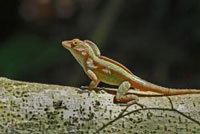Anolis cristatellus, introduced in Miami in 1975, can withstand temperatures 3 degrees cooler.
An introduced lizard species in Miami that is native to Puerto Rico has the capability to adapt to cooler weather more readily than the Puerto Rican specimens, according to a new Duke University study that will appear in the December 6 issue of The American Naturalist. According to the study, "Rapid Change in the Thermal Tolerance of a Tropical Lizard" the Puerto Rican crested anole (Anolis cristatellus) was introduced to the Florida city in 1975, and these lizards have adapted to the cooler winters over 35 generations. While the summers in Miami have similar temperatures to that of their native Puerto Rico, the winter temperatures average 10 degrees Fahrenheit cooler than that of their native range.
Manuel Leal, a Duke University biologist and co-author of the study, and graduate student Alex Gunderson captured specimens from the Pinecrest area in Miami as well as several specimens from northeastern Puerto Rico. They then took the lizards to their lab at Duke where they placed thermometers into the cloaca of each lizard, placed the lizards on their backs, and proceeded to lower the air temperature in the enclosures of the reptiles.
They wanted to gauge at what temperatures the animals would right themselves after being placed on their backs. They watched as the lizards from Florida flipped over at a temperature that was 3 degrees Fahrenheit cooler than when the Puerto Rican lizards righted themselves. Leal said in a news release put out by Duke University that the lizards that flip over at lower temperatures have a higher tolerance for cold weather, indicating that "the thermal physiology of tropical lizards is more easily altered than previously proposed." Leal said that the temperature difference of 3 degrees Fahrenheit is significant when you factor in the physiological changes that took place in the introduced Anolis cristatellus over the course of 35 generations, a time scale that Leal noted can happen during a human lifetime. He also noted that while this lizard's tolerance to cold provides hope for some tropical species, the lizard's tolerance to high temperatures, which Leal and Gunderson are now studying, is unknown.


